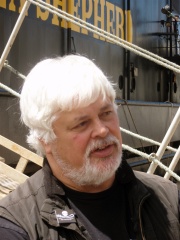
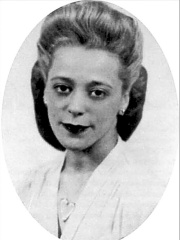


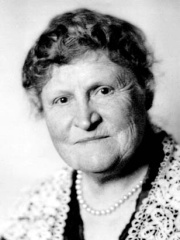
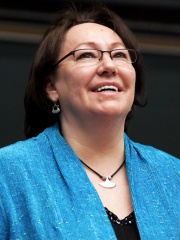

The Most Famous
SOCIAL ACTIVISTS from Canada
This page contains a list of the greatest Canadian Social Activists. The pantheon dataset contains 840 Social Activists, 8 of which were born in Canada. This makes Canada the birth place of the 27th most number of Social Activists behind Uganda, and Indonesia.
Top 8
The following people are considered by Pantheon to be the most legendary Canadian Social Activists of all time. This list of famous Canadian Social Activists is sorted by HPI (Historical Popularity Index), a metric that aggregates information on a biography's online popularity.

1. Paul Watson (b. 1950)
With an HPI of 65.94, Paul Watson is the most famous Canadian Social Activist. His biography has been translated into 28 different languages on wikipedia.
Paul Franklin Watson (born December 2, 1950) is a Canadian-American environmental, conservation and animal rights activist, who founded the Sea Shepherd Conservation Society, an anti-poaching and direct action group focused on marine conservation activism. The tactics used by Sea Shepherd have attracted opposition, with the group accused of eco-terrorism by both the Japanese government and Greenpeace. Watson is a citizen of Canada and the United States. Watson, a native of Toronto, has been an environmental activist since his teens. He joined a Sierra Club protest against nuclear testing in 1969 and crewed on board the Greenpeace Too in November 1971, to oppose nuclear testing at Amchitka Island in the Aleutians. In 1972, he was a co-founder of Greenpeace. Because Watson argued for a strategy of direct action that conflicted with the Greenpeace interpretation of nonviolence, he was ousted from the board in 1977. Greenpeace has since stated that Watson was an influential early member, but not one of the founders of Greenpeace. Watson states that Greenpeace has revised their history but Jerry Rothwells documentary How to Change the World firmly established Watson as the 8th founding member of Greenpeace, with the lifetime membership number of 007 with Robert Hunter being 000. The same year, he formed the Sea Shepherd Conservation Society. The group was the subject of a reality show named Whale Wars. Watson promotes aggressive non-violent intervention to defend marine life and marine eco-systems. He also promotes Biocentrism. Watson's activities have led to legal action from authorities in countries including the United States, Canada, Norway, Costa Rica and Japan. He was detained in Germany on an extradition request by Costa Rica in May 2012. An Interpol red notice was issued on September 14, 2012, at the request of Japan and Costa Rica. Watson has never been convicted of a criminal felony despite numerous arrests during his career. After staying at sea for 15 months following his escape from Germany, where he was released on bail, he returned to Los Angeles in late October 2013, going through customs and "was not arrested". He appeared before a US appeals court on November 6, 2013, stating that neither he nor the Sea Shepherd Conservation Society violated a 2012 order requiring them to leave whaling vessels alone. Although the United States is a signatory member of Interpol, Watson has not been detained for extradition to Japan or Costa Rica. He is living in Paris, writing books, giving lectures and coordinating marine conservation campaigns, currently focusing on opposition to illegal whaling operations and opposition to deep sea mining. In March 2019, Costa Rica dropped all charges against Watson and has removed the Interpol red notice. He has created his own foundation, the Captain Paul Watson Foundation, as Sea Shepherd Conservation Society and the board of Sea Shepherd Global removed him. He has also left the executive office of the Australian branch. In July 2024, Watson was detained in Nuuk in Greenland by the Danish police, citing an Interpol red notice from Japan. He was expected to stay in pre-trial detention until October 2, 2024; Watson and the Captain Paul Watson Foundation filed an appeal with the Supreme Court to have the decision set aside. After his detention was extended several times, on December 17, 2024, the Danish government decided that Watson would not be extradited to Japan. He was released from prison and returned to France.

2. Viola Desmond (1914 - 1965)
With an HPI of 59.19, Viola Desmond is the 2nd most famous Canadian Social Activist. Her biography has been translated into 18 different languages.
Viola Irene Desmond (July 6, 1914 – February 7, 1965) was a Canadian civil and women's rights activist and businesswoman of Black Nova Scotian descent. In 1946, she challenged racial segregation at a cinema in New Glasgow, Nova Scotia, by refusing to leave a whites-only area of the Roseland Theatre. For this, she was convicted of a minor tax violation for the one-cent tax difference between the seat that she had paid for and the seat that she used, which was more expensive. Desmond's case is one of the most publicized incidents of racial discrimination in Canadian history and helped start the modern civil rights movement in Canada. In 2010, Viola Desmond was granted a posthumous free pardon, the first to be granted in Canada. A free pardon deems the person granted the pardon to have never committed the offence and cancels any consequence resulting from the conviction, such as fines, prohibitions or forfeitures. However, it was not until 2021 that the government repaid the $26 (worth $368 CAD as of 2021) fine to her estate in the form of a $1,000 scholarship that adjusted the amount to reflect the time value of money. The Crown-in-Right-of-Nova Scotia also apologized for prosecuting her for tax evasion and acknowledged she was rightfully resisting racial discrimination. In late 2018, Desmond became the first Canadian-born woman to appear alone on a Canadian bank note—a $10 bill—which was unveiled by Finance Minister Bill Morneau and Bank of Canada Governor Stephen Poloz during a ceremony at the Halifax Central Library on March 8, 2018. Desmond was also named a National Historic Person in 2018.

3. John Peters Humphrey (1905 - 1995)
With an HPI of 54.60, John Peters Humphrey is the 3rd most famous Canadian Social Activist. His biography has been translated into 20 different languages.
John Peters Humphrey (April 30, 1905 – March 14, 1995) was a Canadian legal scholar, jurist, and human rights advocate. He is most famous as the principal author of the first draft of the Universal Declaration of Human Rights (UHDR), a foundational document in international human rights law adopted by the United Nations General Assembly in 1948. Humphrey's contributions were recognized with honors including the Order of Canada (1974), the National Order of Quebec (1985), and the UN Human Rights Prize (1988).

4. David Reimer (1965 - 2004)
With an HPI of 54.07, David Reimer is the 4th most famous Canadian Social Activist. His biography has been translated into 26 different languages.
David Reimer (born Bruce Peter Reimer; 22 August 1965 – 4 May 2004) was a Canadian boy raised as a girl following medical advice and intervention after his penis was severely injured during a botched circumcision in infancy. The psychologist John Money oversaw the case and incorrectly reported the reassignment as successful and as evidence that gender identity is primarily learned. The academic sexologist Milton Diamond later reported that Reimer's realization that he was not a girl occurred between the ages of 9 and 11 years and that he was living as a male by the age of 15. Well known in medical circles for years anonymously as the "John/Joan" case, Reimer later went public with his story to help discourage similar medical practices. He killed himself at age 38, two days after separating from his wife.
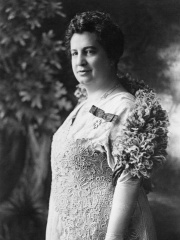
5. Emily Murphy (1868 - 1933)
With an HPI of 49.34, Emily Murphy is the 5th most famous Canadian Social Activist. Her biography has been translated into 21 different languages.
Emily Murphy (born Emily Gowan Ferguson; 14 March 1868 – 26 October 1933) was a Canadian women's rights activist and author. In 1916, she became the first female magistrate in Canada and the fifth in the British Empire after Elizabeth Webb Nicholls, Jane Price, E. Cullen and Cecilia Dixon of Australia (all appointed to office in 1915). She is best known for her contributions to Canadian feminism, specifically to the question of whether women were "qualified persons" to serve in the Senate under Canadian law. Murphy is known as one of "The Famous Five" (also called "The Valiant Five")—a group of Canadian women's rights activists that also included Henrietta Muir Edwards, Nellie McClung, Louise McKinney and Irene Parlby. In 1927, the women launched the "Persons Case," contending that women could be "qualified persons" eligible to sit in the Senate. The Supreme Court of Canada ruled that they were not. However, upon appeal to the Judicial Committee of the British Privy Council, the court of last resort for Canada at that time, the women won their case. However, there has been some criticism of her later work, mainly for her role in the Sexual Sterilization Act of Alberta and her allegations that a ring of immigrants from other countries, particularly China, would corrupt the white race by getting Canadians hooked on drugs. In her book The Black Candle, she wrote: "It is hardly credible that the average Chinese peddler has any definite idea in his mind of bringing about the downfall of the white race, his swaying motive being probably that of greed, but in the hands of his superiors, he may become a powerful instrument to that end."

6. Henrietta Edwards (1849 - 1931)
With an HPI of 48.93, Henrietta Edwards is the 6th most famous Canadian Social Activist. Her biography has been translated into 18 different languages.
Henrietta Muir Edwards (18 December 1849 – 10 November 1931) was a Canadian women's rights activist, author and reformer. She was the eldest of "The Famous Five", along with Emily Murphy, Nellie McClung, Louise McKinney and Irene Parlby, who fought to have women recognized as "persons" under the law, and for the woman's right to vote in elections. She was born Henrietta Louise Muir in Montreal. She grew up in an upper-middle-class family that valued culture and religion. Edwards became active in many religious organisations, where she grew disenchanted with old traditions where the exclusion of women was acceptable.

7. Sheila Watt-Cloutier (b. 1953)
With an HPI of 48.31, Sheila Watt-Cloutier is the 7th most famous Canadian Social Activist. Her biography has been translated into 16 different languages.
Sheila Watt-Cloutier (born 2 December 1953) is a Canadian Inuk activist. She has been a political representative for Inuit at the regional, national and international levels, most recently as International Chair for the Inuit Circumpolar Council (formerly the Inuit Circumpolar Conference). Watt-Cloutier has worked on a range of social and environmental issues affecting Inuit, most recently, persistent organic pollutants and global warming. She has received numerous awards and honours for her work, and has been featured in a number of documentaries and profiled by journalists from all media. Watt-Cloutier sits as an adviser to Canada's Ecofiscal Commission. She is also a senior fellow at the Centre for International Governance Innovation.

8. Autumn Peltier (b. 2004)
With an HPI of 27.47, Autumn Peltier is the 8th most famous Canadian Social Activist. Her biography has been translated into 22 different languages.
Autumn Peltier (born September 27, 2004) is an Anishinaabe Indigenous rights advocate from the Wikwemkong First Nation on Manitoulin Island, Ontario, Canada. She was named Chief Water Commissioner for the Anishinabek Nation in 2019. In 2018, at the age of thirteen, Peltier addressed world leaders at the United Nations General Assembly on the issue of water protection.
People
Pantheon has 8 people classified as Canadian social activists born between 1849 and 2004. Of these 8, 3 (37.50%) of them are still alive today. The most famous living Canadian social activists include Paul Watson, Sheila Watt-Cloutier, and Autumn Peltier. The most famous deceased Canadian social activists include Viola Desmond, John Peters Humphrey, and David Reimer.
Living Canadian Social Activists
Go to all RankingsPaul Watson
1950 - Present
HPI: 65.94
Sheila Watt-Cloutier
1953 - Present
HPI: 48.31
Autumn Peltier
2004 - Present
HPI: 27.47
Deceased Canadian Social Activists
Go to all RankingsViola Desmond
1914 - 1965
HPI: 59.19
John Peters Humphrey
1905 - 1995
HPI: 54.60
David Reimer
1965 - 2004
HPI: 54.07
Emily Murphy
1868 - 1933
HPI: 49.34
Henrietta Edwards
1849 - 1931
HPI: 48.93
Overlapping Lives
Which Social Activists were alive at the same time? This visualization shows the lifespans of the 5 most globally memorable Social Activists since 1700.

